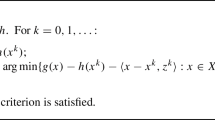Abstract
New versions of the set-valued average value at risk for multivariate risks are introduced by generalizing the well-known certainty equivalent representation to the set-valued case. The first ’regulator’ version is independent from any market model whereas the second version, called the market extension, takes trading opportunities into account. Essential properties of both versions are proven and an algorithmic approach is provided which admits to compute the values of both versions over finite probability spaces. Several examples illustrate various features of the theoretical constructions.
Similar content being viewed by others
Notes
For actual computations, we used a version of the algorithm, BENSOLVE, which is available online at http://ito.mathematik.uni-halle.de/~loehne.
References
Acerbi, C., Tasche, D.: On the coherence of expected shortfall. Journal of Banking and Finance 26, 1487–1503 (2002)
Artzner, P., Delbaen, F., Koch-Medina, P.: Risk measures and efficient use of capital. Astin Bull. 39(1), 101–116 (2009)
Benson, H.P.: An outer approximation algorithm for generating all efficient extreme points in the outcome set of a multiple objective linear programming problem. J. Global Optim. 13(1), 1–24 (1998)
Burgert, C., Rüschendorf, L.: Consistent risk measures for portfolio vectors. Insurance Math. Econom. 38(2), 289–297 (2006)
Ekeland, I., Galichon, A., Henry, M.: Comonotonic measures of multivariate risks. Mathematical Finance 22(1), 109–132 (2012)
Ekeland, I., Schachermayer, W.: Law invariant risk measures in \(L^\infty (R_d)\). Statistics and Risk Modeling 28(3), 195–225 (2011)
Föllmer, H., Schied, A.: Stochastic Finance, 3rd edn. Walter de Gruyter & Co., Berlin (2011)
Hamel, A., Heyde, F.: Duality for set-valued measures of risk. SIAM Journal on Financ. Mathematics 1, 66–95 (2010)
Hamel, A., Heyde, F., Rudloff, B.: Set-valued risk measures for conical market models. Mathematics and Financial Economics 5, 1–28 (2011)
Hamel, A., Löhne, A., Rudloff, B.: A benson type algorithm for linear vector optimization and applications. Submitted for publication (2013)
Hodges, S., Neuberger, A.: Optimal replication of contingent claims under transaction costs. Rev. Futures Markets 8, 222–239 (1989)
Jaschke, S., Küchler, U.: Coherent risk measures and good-deal bounds. Finance Stoch. 5(2), 181–200 (2001)
Jouini, E., Meddeb, M., Touzi, N.: Vector-valued coherent risk measures. Finance and Stochastics 8, 531–552 (2004)
Kabanov, Y.M.: Hedging and liquidation under transaction costs in currency markets. Finance and Stochastics 3(2), 237–248 (1999)
Kabanov, Y.M., Safarian, M.: Markets with Transaction Costs: Mathematical Theory. Springer, Springer Finance (2009)
Korn, R., Müller, S.: The decoupling approach to binomial pricing of multi-asset options. J. Comput. Finance 12(3), 1–30 (2009)
Löhne, A.: Vector Optimization with Infimum and Supremum. Springer, (2011)
Löhne, A., Rudloff, B.: An algorithm for calculating the set of superhedging portfolios in markets with transaction costs. ArXiv e-prints (2011). Submitted for publication
Löhne, A., Rudloff, B.: On solvency cones and their duals in markets with transaction costs. Working paper (2013)
Pflug, G.C.: Some remarks on the value-at-risk and the conditional value-at-risk. In: Probabilistic constrained optimization, Nonconvex Optim. Appl., vol. 49, pp. 272–281. Kluwer Acad. Publ., Dordrecht (2000)
Rockafellar, R.T., Uryasev, S.P.: Optimization of conditional value-at-risk. Journal of risk 2, 21–42 (2000)
Schachermayer, W.: The fundamental theorem of asset pricing under proportional transaction costs in finite discrete time. Mathematical Finance 14(1), 19–48 (2004)
Yankova, M.: Set-valued Average Value at Risk with random transaction costs (2011). Senior thesis, Princeton University
Acknowledgments
The authors emphasize that this project benefited from discussions with Frank Heyde (about the primal definition of AV@R) and Andreas Löhne (about the computational part). We are grateful to the referees of a previous version for their constructive remarks. Birgit Rudloff’s research was supported by NSF award DMS-1007938.
Author information
Authors and Affiliations
Corresponding author
Rights and permissions
About this article
Cite this article
Hamel, A.H., Rudloff, B. & Yankova, M. Set-valued average value at risk and its computation. Math Finan Econ 7, 229–246 (2013). https://doi.org/10.1007/s11579-013-0094-9
Received:
Accepted:
Published:
Issue Date:
DOI: https://doi.org/10.1007/s11579-013-0094-9
Keywords
- Average value at risk
- Set-valued risk measures
- Coherent risk measures
- Transaction costs
- Benson’s algorithm




